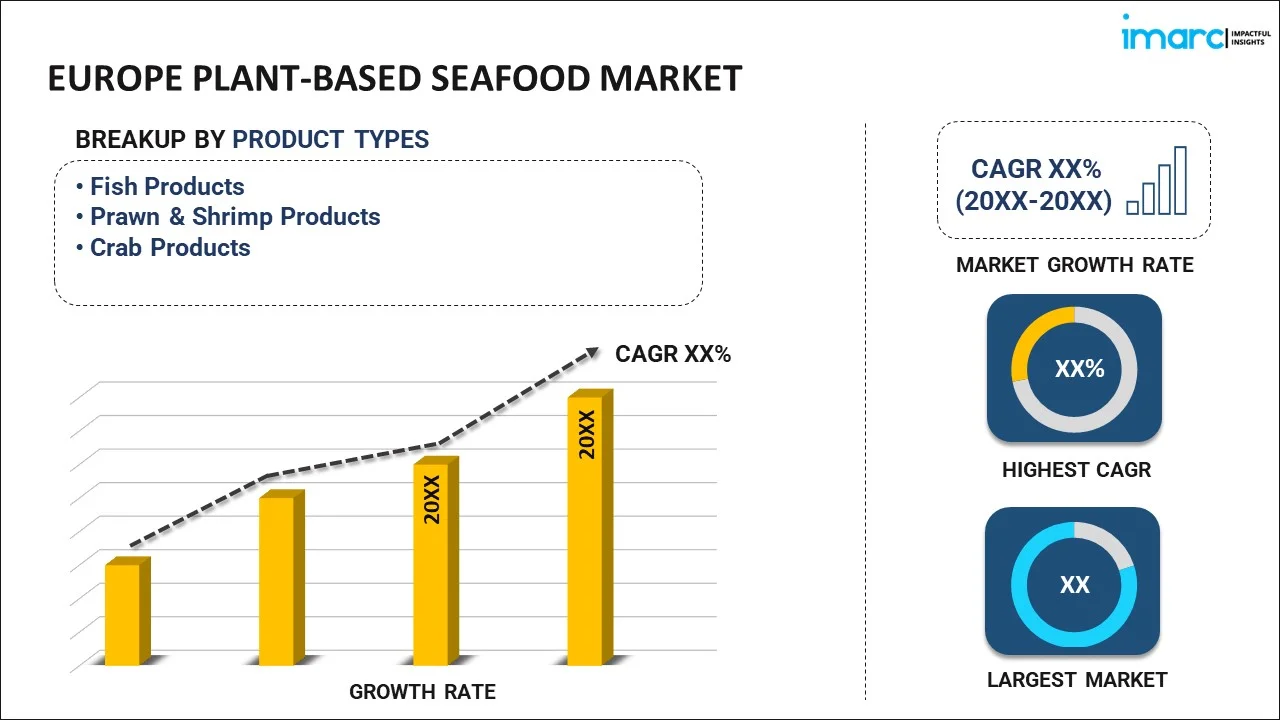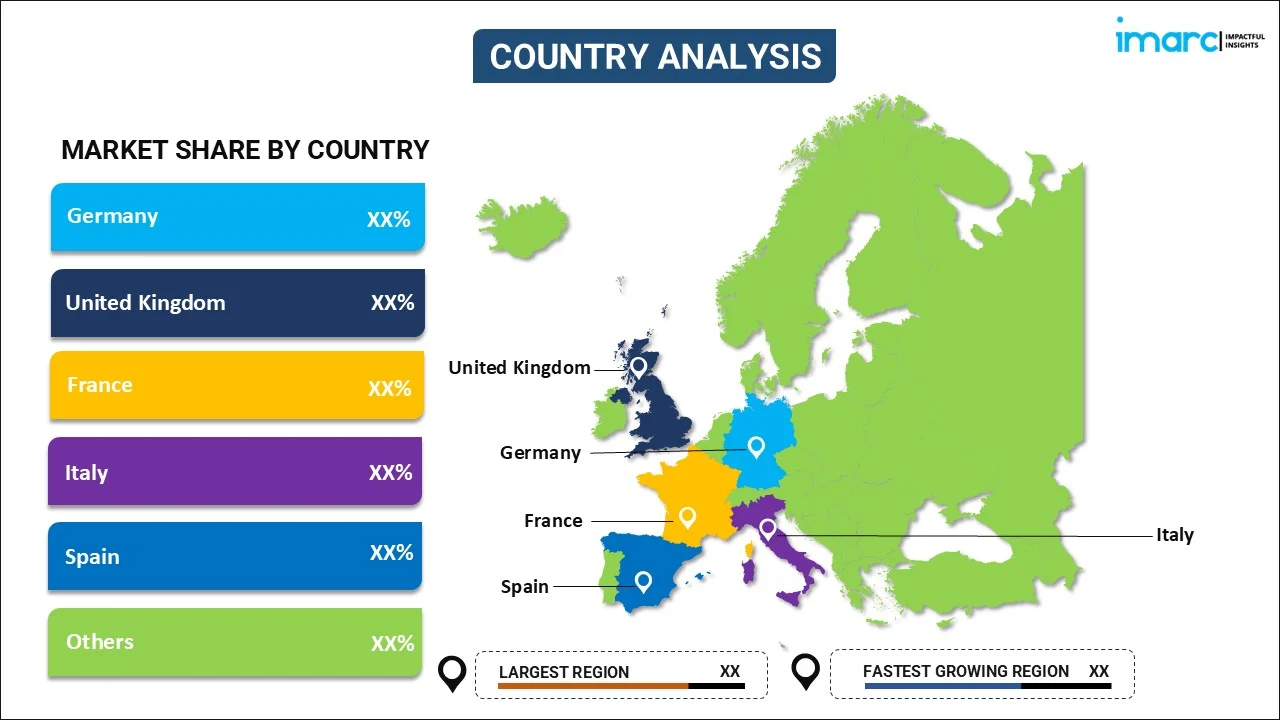
Europe Plant-based Seafood Market Report by Product Type (Fish Products, Prawn & Shrimp Products, Crab Products), Distribution Channel (Supermarkets and Hypermarkets, Convenience Stores, Online, and Others), and Country 2025-2033
Market Overview:
The Europe plant-based seafood market size reached USD 68.2 Million in 2024. Looking forward, IMARC Group expects the market to reach USD 521.0 Million by 2033, exhibiting a growth rate (CAGR) of 24.08% during 2025-2033. The wide availability through various distribution channels, increasing environmental concerns, and rising awareness about animal welfare represent some of the key factors driving the market.
|
Report Attribute
|
Key Statistics
|
|---|---|
|
Base Year
|
2024
|
|
Forecast Years
|
2025-2033
|
|
Historical Years
|
2019-2024
|
|
Market Size in 2024
|
USD 68.2 Million |
|
Market Forecast in 2033
|
USD 521.0 Million |
| Market Growth Rate 2025-2033 | 24.08% |
Plant-based seafood refers to a vegan alternative that is similar to seafood in texture, taste, and color. It comprises various ingredients, such as soy, seaweed, yeast, legumes, vegetable oil, and starches. It is widely available in the form of tuna, salmon, crab, shrimp, squid, caviar, and scallops. It is a rich source of protein, omega 3, and does not involve mercury, which enhances the absorption of nutrients while reducing heavy metal toxicity in the body. It improves cholesterol levels and blood pressure while reducing the risk of various infections. It assists in increasing palatability of the food and prevents type 2 diabetes and certain kinds of cancers. As it is utilized in preparing various healthy and delicious vegan dishes, the demand for plant-based seafood is increasing in Europe.
Europe Plant-Based Seafood Market Trends:
At present, the rising demand for plant-based seafood on account of the increasing prevalence of zoonotic diseases among humans represents one of the key factors contributing to the growth of the market in Europe. In addition, the increasing demand for plant-based protein due to the popularity of vegetarianism among consumers is bolstering the growth of the market across the region. Apart from this, the rising demand for ready-to-eat (RTE), canned, and frozen plant-based seafood products among consumers due to hectic lifestyles is offering lucrative growth opportunities to industry investors in the region. Moreover, governing agencies in Europe are encouraging the adoption of sustainable plant-based seafood to avoid the depletion of fisheries and natural ocean resources, which is positively influencing the market. Besides this, the growing demand for plant-based seafood over animal-based products due to the increasing environmental concerns among individuals is offering a positive market outlook. Additionally, the rising demand for plant-based diet, as it assists in encouraging weight loss and reducing the risk of numerous cardiovascular diseases, such as heart attack and stroke among individuals, is supporting the growth of the market in Europe. In line with this, the wide availability of plant-based seafood through various distribution channels, such as supermarkets, hypermarkets, specialty, and convenience and online stores, is propelling the growth of the market in the region. Furthermore, the rising awareness about animal welfare among individuals in Europe is strengthening the market growth.
Key Market Segmentation:
IMARC Group provides an analysis of the key trends in each sub-segment of the Europe plant-based seafood market report, along with forecasts at the regional and country level from 2025-2033. Our report has categorized the market based on product type and distribution channel.
Product Type Insights:

- Fish Products
- Prawn & Shrimp Products
- Crab Products
The report has provided a detailed breakup and analysis of the Europe plant-based seafood market based on the product type. This includes fish products, prawn and shrimp products, and crab products. According to the report, fish products represented the largest segment.
Distribution Channel Insights:
- Supermarkets and Hypermarkets
- Convenience Stores
- Online
- Others
A detailed breakup and analysis of the Europe plant-based seafood market based on the distribution channel has also been provided in the report. This includes supermarkets and hypermarkets, convenience stores, online, and others. According to the report, supermarkets and hypermarkets accounted for the largest market share.
Country Insights:

- Germany
- France
- United Kingdom
- Italy
- Spain
- Others
The report has also provided a comprehensive analysis of all the major country markets, which include Germany, France, the United Kingdom, Italy, Spain, and Others. According to the report, Germany was the largest market for Europe plant-based seafood. Some of the factors driving the Germany plant-based seafood market included the increasing vegetarian population, introduction of the alternative for fish by key manufacturers, rising awareness about animal welfare, etc.
Competitive Landscape:
The report has also provided a comprehensive analysis of the competitive landscape in the Europe plant-based seafood market. Competitive analysis such as market structure, market share by key players, player positioning, top winning strategies, competitive dashboard, and company evaluation quadrant has been covered in the report. Also, detailed profiles of all major companies have been provided.
Report Coverage:
| Report Features | Details |
|---|---|
| Base Year of the Analysis | 2024 |
| Historical Period | 2019-2024 |
| Forecast Period | 2025-2033 |
| Units | Million USD |
| Segment Coverage | Product Type, Distribution Channel, Country |
| Countries Covered | Germany, France, United Kingdom, Italy, Spain, Others |
| Customization Scope | 10% Free Customization |
| Post-Sale Analyst Support | 10-12 Weeks |
| Delivery Format | PDF and Excel through Email (We can also provide the editable version of the report in PPT/Word format on special request) |
Key Benefits for Stakeholders:
- IMARC’s report offers a comprehensive quantitative analysis of various market segments, historical and current market trends, market forecasts, and dynamics of the Europe plant-based seafood market from 2019-2033.
- The research study provides the latest information on the market drivers, challenges, and opportunities in the Europe plant-based seafood market.
- The study maps the leading, as well as the fastest-growing, regional markets.
- Porter's five forces analysis assist stakeholders in assessing the impact of new entrants, competitive rivalry, supplier power, buyer power, and the threat of substitution. It helps stakeholders to analyze the level of competition within the Europe plant-based seafood industry and its attractiveness.
- Competitive landscape allows stakeholders to understand their competitive environment and provides an insight into the current positions of key players in the market.
Key Questions Answered in This Report
The Europe plant-based seafood market was valued at USD 68.2 Million in 2024.
We expect the Europe plant-based seafood market to exhibit a CAGR of 24.08% during 2025-2033.
The sudden outbreak of the COVID-19 pandemic has led to the changing consumer inclination from conventional brick-and-mortar distribution channels towards online retail platforms for the purchase of plant-based seafood across several European nations.
The emerging trend of veganism, along with the growing concerns regarding animal cruelty among individuals, are primarily driving the Europe plant-based seafood market.
Based on the product type, the Europe plant-based seafood market has been divided into fish products, prawn & shrimp products, and crab products. Currently, fish products hold the majority of the total market share.
Based on the distribution channel, the Europe plant-based seafood market can be bifurcated into supermarkets and hypermarkets, convenience stores, online, and others. Among these, supermarkets and hypermarkets exhibit a clear dominance in the market.
On a regional level, the market has been classified into Germany, France, United Kingdom, Italy, Spain, and others, where Germany currently dominates the Europe plant-based seafood market.
Need more help?
- Speak to our experienced analysts for insights on the current market scenarios.
- Include additional segments and countries to customize the report as per your requirement.
- Gain an unparalleled competitive advantage in your domain by understanding how to utilize the report and positively impacting your operations and revenue.
- For further assistance, please connect with our analysts.
 Inquire Before Buying
Inquire Before Buying
 Speak to an Analyst
Speak to an Analyst
 Request Brochure
Request Brochure
 Request Customization
Request Customization




.webp)




.webp)












